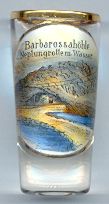

|
| DEUTSCHLAND | GERMANY |
| Bundesland: Freistaat Thüringen | Thuringia |
| Landkreis: Kyffhäuserkreis |
 The
The  Barbarossa Cave [left] near Bad Frankenhausen in the Kyffhäuser district of Thuringia
was discovered by chance in 1865. Copper slate had been mined in the Mansfeld area since about 900 years ago but never had been really profitable.
A new attempt to find copper slate was made in 1860 by drilling a new gallery into the mountain.
Five years later, on 23 December 1865, the gallery opened up into a cave of impressive dimensions.
Although copper slate was indeed discovered some time later in another gallery, mining was abondoned because of the low copper content.
Therefore, the cave was adapted for visitors, the first of which were admitted to the cave in January 1866.
In 1895 an electrical lighting system was installed, and in 1898 a new access gallery was opened.
The picture on the glass shows 'Neptun's Grotto'.
New caverns (the continuation from the 'Cave Lake' to the 'Cathedral') were discovered in 1913 followed by the construction in 1926 of a new exit gallery.
Further parts of the cave were discovered in 1935 (the 'Good Friday Caverns') and 1954.
The numbers of visitors increased especially after the construction in 1890–1896 of the Kyffhäuser Monument.
Today the cave is visited by about 200,000 visitors per year.
Barbarossa Cave [left] near Bad Frankenhausen in the Kyffhäuser district of Thuringia
was discovered by chance in 1865. Copper slate had been mined in the Mansfeld area since about 900 years ago but never had been really profitable.
A new attempt to find copper slate was made in 1860 by drilling a new gallery into the mountain.
Five years later, on 23 December 1865, the gallery opened up into a cave of impressive dimensions.
Although copper slate was indeed discovered some time later in another gallery, mining was abondoned because of the low copper content.
Therefore, the cave was adapted for visitors, the first of which were admitted to the cave in January 1866.
In 1895 an electrical lighting system was installed, and in 1898 a new access gallery was opened.
The picture on the glass shows 'Neptun's Grotto'.
New caverns (the continuation from the 'Cave Lake' to the 'Cathedral') were discovered in 1913 followed by the construction in 1926 of a new exit gallery.
Further parts of the cave were discovered in 1935 (the 'Good Friday Caverns') and 1954.
The numbers of visitors increased especially after the construction in 1890–1896 of the Kyffhäuser Monument.
Today the cave is visited by about 200,000 visitors per year.
The cave is named for Emperor Friedrich I "Barbarossa" (b. ca.1122, German King 1152, Emperor 1155, d. 1190).
According to the popular legend, which goes back to the 16th century, the Emperor did not die, but is only asleep sitting at a marble table
in a palace deep within the Kyffhäuser mountain as long as ravens fly around the mountain.
![[scale]](lineal.jpg)